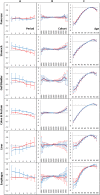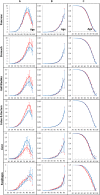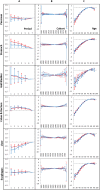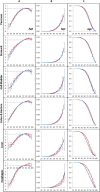Invariant Characteristics of Carcinogenesis
- PMID: 26465159
- PMCID: PMC4605720
- DOI: 10.1371/journal.pone.0140405
Invariant Characteristics of Carcinogenesis
Abstract
Carcinogenic modeling is aimed at mathematical descriptions of cancer development in aging. In this work, we assumed that a small fraction of individuals in the population is susceptible to cancer, while the rest of the population is resistant to cancer. For individuals susceptible to cancer we adopted methods of conditional survival analyses. We performed computational experiments using data on pancreatic, stomach, gallbladder, colon and rectum, liver, and esophagus cancers from the gastrointestinal system collected for men and women in the SEER registries during 1975-2009. In these experiments, we estimated the time period effects, the birth cohort effects, the age effects and the population (unconditional) cancer hazard rates. We also estimated the individual cancer presentation rates and the individual cancer resistance rates, which are, correspondingly, the hazard and survival rates conditioned on the susceptibility to cancer. The performed experiments showed that for men and women, patterns of the age effects, the individual cancer presentation rates and the individual cancer resistance rates are: (i) intrinsic for each cancer subtype, (ii) invariant to the place of living of the individuals diagnosed with cancer, and (iii) well adjusted for the modifiable variables averaged at a given time period. Such specificity and invariability of the age effects, the individual cancer presentation rates and the individual cancer resistance rates suggest that these carcinogenic characteristics can be useful for predictive carcinogenic studies by methods of inferential statistics and for the development of novel strategies for cancer prevention.
Conflict of interest statement
Figures









References
Publication types
MeSH terms
Grants and funding
LinkOut - more resources
Full Text Sources
Other Literature Sources

